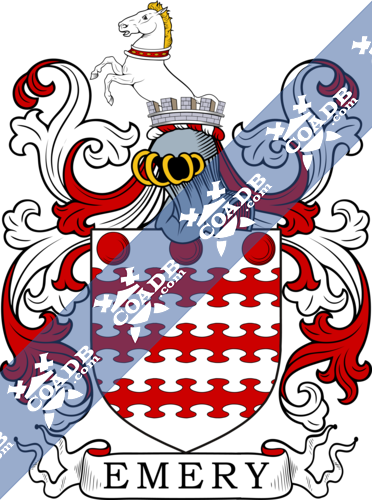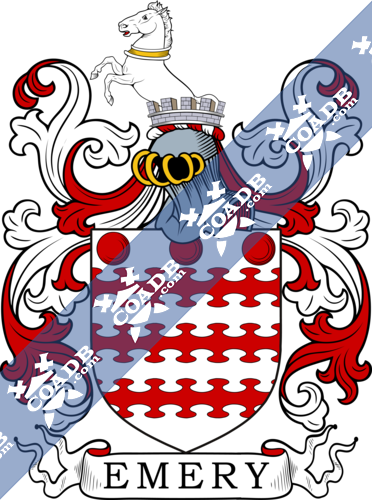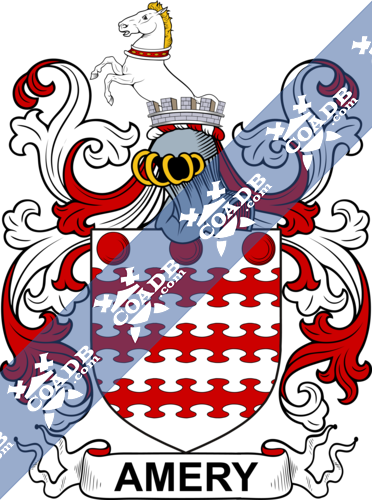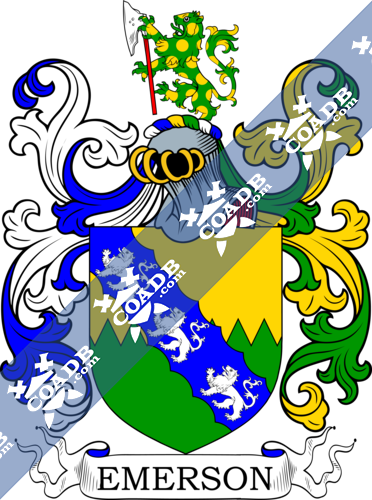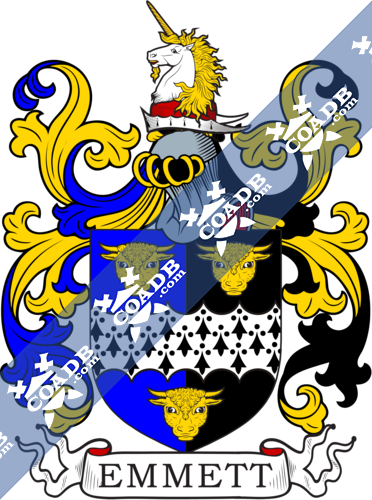Emery Family Crest, Coat of Arms and Name History

Emery Coat of Arms Gallery
Don’t know which Coat of Arms is yours?
We can do a genealogical research. Find out the exact history of your family!
Learn MoreEmery
Emery is a Germanic name originally meaning, one who is an industrious, or a powerful worker. After the name was introduced to the Frankish Empire under Charlemagne the spelling evolved to Emery. It is one of the Norman-French names which crossed the channel with William the Conqueror. Because of its Germanic roots, it made an easy translation into the Anglo-Saxon culture the Normans ruled over, therefore there is little derivative changes in the name, Amory, Emmory, Elmwy, Emory and Emery are all variations which fall into the changing times of the Conquest. Elmwy appears in the names listed in the Doomsday Book, a comprehensive listing of all persons, personages and properties within England who might be taxed by their new Norman lords.
The name appears in Essex, Somerset, and Kent. With the earliest appearance listed as Elmwy the Reeve, in the border region between Oxfordshire and Berkshire at roughly 1086 through 1087, roughly twenty years after the invasion. A Reeve, in the time of the Norman conquest became one of the first examples of an estate manager, and adjudicator of all day-to-day operations of a lord’s holdings. He oversaw the serfs and their efforts along with collecting tithes, taxes and settling of disputes which did not involve a capital offense such as poaching.
It is reported in 1389 the Emmory family had settled in a location which would be later called Emmory Down. It is a small village set on the edge of the New Forest. The New Forest was a series of lands which William the Conqueror had cleared of human habitation and joined together into one tract of land in 1170, so he and his heirs would have a royal hunting grounds. It was at one time the single largest tract of continuous land within England. The majority of which still stands today and is still owned by the British Crown. Emmory Down is also notable in the literary world for being the location where the research and basic outline for Sir Arthur Conan Doyle’s White Company, was written. Sir Arthur Conan Doyle spent almost a year living in the district while he wrote his medieval adventure novel.
The first recorded Emery family members to land in the Americas, were brothers Anthony, and John Emery, with Anthony’s son James Emery accompanying them. The family left their Romesy, Hampshire England home and in 1635 they traveled to Wiltshire; then with roughly a hundred other English settlers sailed upon the named the James bound for Massachusetts. The Newbury settlement or plantation, was a commercial venture, as at the time of its founding Europe was coming out of the religious wars of the 17th century which had decimated the population, and trade for commodities was at an all time high. England was in short supply of all things agricultural to feed their growing cities such as London. Fish, Wool, Beef were all highly prized not to mention wood like white pine, and oak needed to build ships for merchants and the growing English navy.
Within a year of its founding, over fifteen ships had landed at Newbury and large herds of imported beef were being raised. The plantation was soon a commercial success. Anthony and James Emery both carpenters moved north to New Hampshire and later relocated just across the border to Kittery Maine which sits on the estuary of where the Pisaquata River meets the Atlantic Ocean. Shortly after Kittery was founded turned into a major ship building port. John Emery remained in Newbury.
In 1875 The Utah territory saw another Emery emerge from New England. George W. Emery of Penobscot, Maine was appointed territorial governor. He had a successful and conciliatory administration, and he built firm and lasting relationships with the settlers in the region. Emery County and the town of Emery, Utah are both named after him.
Emery South Dakota was named after local rancher and farmer S. M. Emery who allowed the city plotted map to be nailed to one of his trees for citizens to look at and use a a guide to purchasing building lots.
In the far flung Emery diaspora the variant of the name Emory has probably become the most famous. Of its most illustrious past members is the Reverend John Emory (1789-1835) a Methodist minister and later Bishop within the Methodist Church, Emory College was created in his name shortly after he died in a tragic carriage accident in 1835. Emory College became Emory University in 1915 and is one of the oldest universities in the country.
Another Emory of interest was Major General Emory a noted cartographer before the American Civil War. He was the definitive surveyor and map maker who surveyed the Gadsden Purchase and the Texas border with Mexico. Special Forces training facility , Fort Emory was named for General Emory as well as Emory Peak in the Big Bend National Park, Texas and in honor of his cartographic skills, Emory Crater on the Moon was named after him by the crew of Apollo 17.
Blazons & Genealogy Notes
1) (Little Baddow, co. Essex). Ar. three bars nebulee gu. in chief as many torteaux. Crest—Out of a mural crown ppr. a demi horse ar. maned or, collared gu. studded gold.
2) (The Grange, Banwell, co. Somerset). Motto—Fidis et suavis. Same Arms. Crest—Out of a mural crown a demi horse collared.
3) (co. Kent). Gu. three bars or, in chief as many cinquefoils of the second. Crest—A demi unicorn ramp. and erased gu. hoofed and armed or, crined sa.
4) (co. Kent). Barry of six gu. and or, in chief three cinquefoils slipped of the second.

